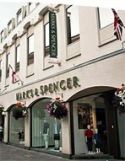Oct 22, 2003Oct. 23, 2003 - Marks & Spencer, one of Britain's biggest retailers, began a trial to track clothing as it moves from one of the company's distribution centers to a single store. The retailer consulted with privacy groups and took pains to address the privacy implications of the trial, setting an example for others in the retail industry.
"We consulted with three groups, two in this country and CASPIAN in the United States," says Liz Freeborn, a spokesperson for Marks & Spencer, referring to Consumers Against Supermarket Privacy Invasion and Number, a group that opposes the use of RFID tags in consumer products. "We understand their concerns and have been open with them all along the line."
CASPIAN opposes all use of RFID tags, but the group has said proposed legislation in the United States that would require companies to inform consumers when they are purchasing items with RFID tags, to give consumers the option to kill or remove the tags and to prevent companies from associating the unique identifier on an item's tag with the person who purchases that item.
Other trials have been done secretively by retailers in the U.S. Consumers were not notified that they were purchasing tagged items, and the tags were allowed to remain active even after the items were purchased. That raised concerns among privacy advocates. However, Marks & Spencer has voluntarily done all of the things that CASPIAN seeks in its proposed legislation.
For the trial, which started on Oct. 13, Marks & Spencer is using Intelligent Labels, which are RFID tags developed by Paxar, a White Plains, N.Y., retail technology company, and Dewhirst, a major supplier of clothing to Marks & Spencer, with funding from the U.K. Department of Trade and Industry. The cardboard label is attached to the garments as a hangtag, similar to a price tag. Each contains a microchip from EM Microelectronic that stores a unique, random serial number that is associated with the item.
The retailer is putting the labels—which are passive UHF (868 MHz) tags with a read range of one and a half feet (half a meter)—on a selection of men's suits, shirts and ties at a distribution center and shipping them to its store in High Wycombe. The tags are designed to be cut off by the consumer following a purchase and thrown away. Shirts are put in a clear plastic bag onto which a self-adhesive RFID label has been placed. Consequently, when the bag gets thrown away by the consumer, so does the RFID tag. Marks & Spencer does not record which customers purchased which specific items of apparel. The retailer also gives an informational brochure about the RFID tags to each consumer who buys a tagged item.
CASPIAN acknowledged that Marks & Spencer has taken a socially responsible position by informing consumers, by enabling consumers to easily remove the tags and by not using RFID tags at the point of checkout to record which item were purchased by which customers. Nonetheless, the group denounced the retailers' trial in a press release, saying it set a "dangerous precedent" by putting RFID tags in clothes.
But Freeborn says Marks & Spencer has not received any negative feedback from its customers. The retailer plans to hire a market research firm to conduct interviews with customers to understand their reaction to the technology and their concerns. The results will be made public and will also be factored into any decision by the retailer to deploy RFID for tracking clothes.
The aim of the trial, which is scheduled to last four weeks, is to determine the feasibility and benefits of tagging clothing. During the trial, the retailer is working with Intellident, a U.K. systems integrator that handled Marks & Spencer's tagging of more than 3 million reusable trays in its produce business. Intellident installed portals with specially modified 868 MHz multifrequency, multiprotocol readers from SAMSys Technologies at Marks & Spencer's distribution center and the loading bay of the store. The portals allow workers to push wheeled racks of hanging garments and carts containing packaged garments through and read all of the tags automatically.
The tags are read as the garments leave the distribution center to confirm the accuracy of the stock pick. If wrong items were selected, the system will alert the operator that the garments do not match those ordered by the store. When garments arrive at the store, they are pushed again through a portal to confirm that the store has received everything it ordered. Staff in the store use the same SAMSys reader on a cart with a handheld antenna to scan items on the shop floor in order to record the entire inventory of tagged items. This can ensure that items are replenished when necessary. Standard bar code system is used to transact the purchase at the point of purchase.
"We want to test every aspect of the system in the store environment," says Freeborn. "When it's raining outside, will the humidity affect the performance of the tags? When suits are bunched close together on the racks, will we still be able to read all the tags? If the tags get bent, will they still function? We really want to see if the system is robust enough in the store."
Freeborn says it's too early to say how well the system is functioning and what the potential benefits might be.
Nearly 95 percent of attendees at RFID Journal University in New York said they would recommend the program to a colleague. There’s still time to sign up for RFID Journal University in Atlanta (Nov. 3) or Chicago (Nov. 17). Register now by visiting RFID Journal University, or call 510-832-1501.


